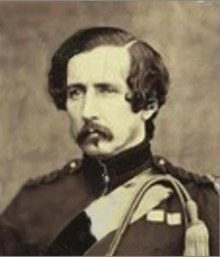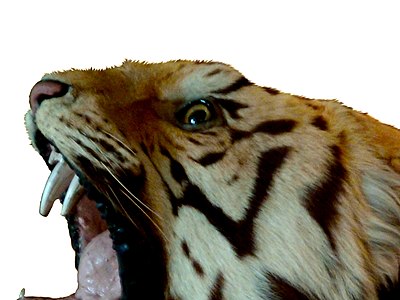
The International Exhibition of 1862, or the Great London Exposition, was a world's fair held from 1 May to 1 November 1862, beside the gardens of the Royal Horticultural Society, South Kensington, London, England, on a site that now houses museums including the Natural History Museum and the Science Museum.
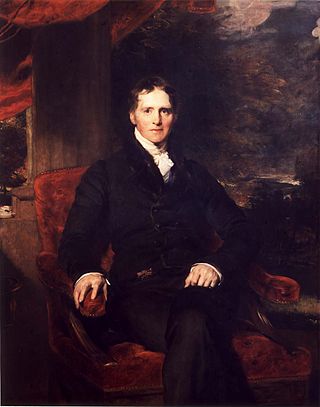
Benjamin Gott was one of the leading figures in the industrial revolution, in the field of textiles. His factory at Armley Mills, Armley, Leeds, was once the largest factory in the world and is now home to the Leeds Industrial Museum at Armley Mills.
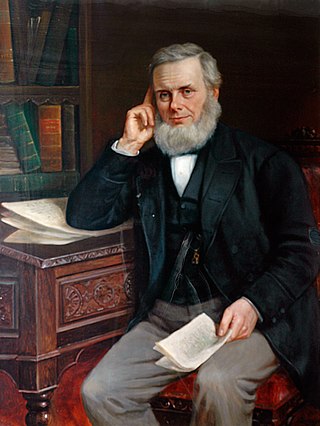
William Grainge was an English antiquarian and poet, and a historian of Yorkshire. He was born into a farming family in Dishforth and grew up on Castiles Farm near Kirkby Malzeard in the North Riding of Yorkshire, where he studied the archaeological site beneath the farm buildings, now known as Cast Hills settlement. Although he left school at age 12, he educated himself well enough to become a clerk to a solicitors' firm in Boroughbridge. He later established a bookshop in Harrogate and published numerous books on local history and topography, besides publishing a number of anonymous poems and discourses about local natural history.

Leeds Art Gallery in Leeds, West Yorkshire, England, is a gallery, part of the Leeds Museums & Galleries group, whose collection of 20th-century British Art was designated by the British government in 1997 as a collection "of national importance". Its collection also includes 19th-century and earlier art works. It is a grade II listed building owned and administered by Leeds City Council, linked on the West to Leeds Central Library and on the East via a bridge to the Henry Moore Institute with which it shares some sculptures. A Henry Moore sculpture, Reclining Woman: Elbow (1981), stands in front of the entrance. The entrance hall contains Leeds' oldest civic sculpture, a 1712 marble statue of Queen Anne.

Leeds City Museum, originally established in 1819, reopened in 2008 in Leeds, West Yorkshire, England. It is housed in the former Mechanics' Institute built by Cuthbert Brodrick, in Cookridge Street. It is one of nine sites in the Leeds Museums & Galleries group.
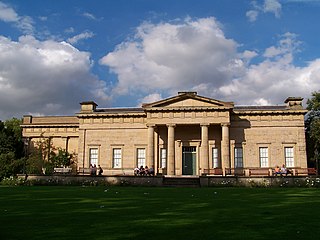
The Yorkshire Museum is a museum in York, England. It was opened in 1830, and has five permanent collections, covering biology, geology, archaeology, numismatics and astronomy.

Leeds Philosophical and Literary Society is a learned society in Leeds, West Yorkshire, England. It was founded in 1819, and its museum collection forms the basis of Leeds City Museum, which reopened in September 2008. The printed works and papers of the society are held by Leeds University Library. The Society is a registered charity under English law.

St Bartholomew's Church, Armley is a parish church in the Church of England in Armley, West Yorkshire. The church is one of two Church of England churches in Armley; the other being Christ Church. Worship at St Bartholomew's is firmly rooted in the Anglo-Catholic tradition of the Church of England with a solemn mass being celebrated weekly.

Thomas Sheppard was a British museum curator and amateur geologist, who founded several museums in Kingston upon Hull and in the East Riding of Yorkshire, England.
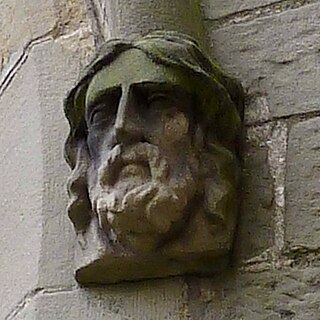
William Ingle was an architectural sculptor in Leeds, West Yorkshire, England. He specialised in delicately undercut bas relief and small stand-alone stone sculptures of natural and imaginary flora and fauna on churches and on civic, commercial and domestic buildings. He was apprenticed to his uncle Robert Mawer. After Mawer's death in 1854 he worked in partnership with his aunt Catherine Mawer and his cousin Charles Mawer in the company Mawer and Ingle. Notable works by Ingle exist on Leeds Town Hall, Endcliffe Hall, Sheffield and Moorlands House, Leeds. He sometimes exhibited gentle humour in his ecclesiastical work, such as faces peering through greenery, and mischievous humour on secular buildings, such as comic rabbits and frogs among foliage. He died of tuberculosis at age 41 years, having suffered the disease for two years.

Leeds Museums and Galleries is a museum service run by the Leeds City Council in West Yorkshire. It manages nine sites and is the largest museum service in England and Wales run by a local authority.
The Willson Group of artists was an English Quaker family of about seven landscape, portrait and caricature painters. Members included John Joseph Willson, his sister Hannah Willson, his wife Emilie Dorothy Hilliard, and their four children, Michael Anthony Hilliard Willson, twins Margaret Willson and E. Dorothy Willson, and Mary Hilliard Willson.

Violet Mary Crowther was a British museum curator. She was the Assistant Curator at the Abbey House Museum for more than two decades.

Hilda Annetta Walker FRSA was an English sculptor, and a painter of landscapes, seascapes and horses, flourishing between 1902 and 1958. She was a war artist painting in England during the First and Second World Wars, and described as "escapist". Some of her early work was the production of oilette postcard paintings for Raphael Tuck & Sons, of firemen and horses. She was born in Mirfield, Yorkshire, England, to a family of blanket manufacturers who had the means to foster her art education. She grew up in the Protestant work ethic of Congregationalism, and attended Leeds College of Art, where she studied under William Gilbert Foster of the Staithes group and William Charles Holland King, sculptor of Dover Marine War Memorial. She signed her works "Hilda Walker" or sometimes "Hilda A. Walker".

General Sir Charles Reid was an officer in the East India Company and later Indian Army, and aide-de-camp to Queen Victoria.

William Gott, was a British wool merchant, mill owner, philanthropist towards public services and art collector from Leeds, West Riding of Yorkshire, England.

The Armley Hippo, previously known as the Leeds Hippopotamus, is a partial skeleton of a common hippopotamus consisting of 122 bones, of which 25 were taxidermy-mounted in 2008 by James Dickinson for display at Leeds City Museum in Leeds, West Yorkshire, England. The skeleton dates to the last interglacial (Eemian) around 130,000 to 115,000 years ago.

James Arnold Dickinson, MBE, is a British conservation-restoration taxidermist who repaired mounted animal skins and skeletons for museums in the United Kingdom for 40 years. Among his restoration works are the Leeds Irish elk, the Leeds polar bear, the Armley Hippo, and the Warrington seal.

Harry Ferris Brazenor was a British taxidermist. He was known especially for his work for Manchester and Salford museums, besides other institutions in Northern England. At Manchester Museum he was recognised for his taxidermy-mounted sperm whale skeleton, giraffe, polar bear, and a wolf with painted "blood" on its teeth. His work for Salford Museum included an Asian elephant displayed next to a tiny shrew. His Salford tiger was transferred to Leeds City Museum and is still displayed there. For Hancock Museum at Newcastle-on-Tyne he mounted a bison bull, and for the former Belle Vue Zoological Gardens he mounted an Indian rhinoceros.

Thomas Holroyd was an English portrait and landscape painter working in Harrogate, North Riding of Yorkshire, England. Before his marriage he undertook painting tours to the United States, Canada, Europe, Egypt, Russia and the Holy Land. Returning to Harrogate, he painted portraits of the local worthies there. He shared responsibility for the successful photography business T & J Holroyd with his brother James, and continued to run the business after his brother died. Holroyd was a founding member of Harrogate Liberal Club.

